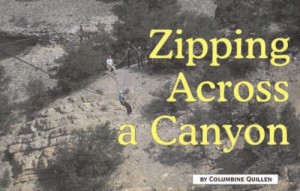Review by Ed Quillen
Colorado Lore – September 2006 – Colorado Central Magazine
Colorado Curiosities – Quirky Characters, Roadside Oddities & Other Offbeat Stuff
by Pam Grout
Published in 2006 by Insiders Guide an imprint of Globe Pequot Press
ISBN 0-7627-3978-9
THIS BOOK more than lives up to its title. I’ve lived in this state all my life, and I cherish its peculiarities. And there are many in this book that I had missed, even though I must have driven past them.
For instance, I’ve often driven on Colo. 115 to get to Colorado Springs, but I’ve never noticed the 21-foot-high “World’s Largest Rocking Chair” in Penrose, outside Doxey’s Apple Shed Mercantile and Café. The book points out that despite the sign, this may not be the largest, since there’s one in Texas that is five feet higher. On the other hand, the Colorado chair weighs 9,100 pounds and the Lone Star chair only 8,000 — so it all depends on how you define “largest.”
Anyone who’s driven through Pueblo has seen the murals painted on the concrete walls that channel the Arkansas River there. They’re interesting, and the story behind them is, too:
“In the 1970s, some college students, late at night with nothing to do, took paint to the 45-degree levee walls. One painting led to two, and before long, city officials decided to make it official, starting what is now known as the Pueblo Levee Project. In an ingenious move normally not attributed to politicians, they decided that rather than dispose of the paint collected during the annual Toxic Waste Day, they’d use the half-filled cans to spruce up the levee. Locals were invited to express themselves however they saw fit. Its two miles of art shows off everything from Andy Warhol replicas to depictions of women in history.”
All over Colorado, there’s weird stuff; this book does not neglect our eastern plains, where you can find the Wonder Tower at Genoa, a gas station made of petrified wood in Lamar, a washing-machine museum in Eaton, and a watch-the-prairie-chickens-mate festival near Wray.
As for our part of the world, the attractions of Fairplay (the real South Park City) and Leadville (such as St. Patrick’s Practice Day) are duly noted, and there’s a fine recollection of Woody, the Twin Lakes town cop. Our Highway 17’s strange spots, like the Gator Farm and the UFO watchtower, fit well in the book, and there’s more from the San Luis Valley.
Salida apparently isn’t too weird; it only gets in for the Angel of Shavano. And neither is Gunnison, noted only for its whitewater park. But Telluride and Crested Butte each get their own chapters.
Colorado Curiosities is fun, but I had some problem with its organization. The chapter of “College Towns” naturally includes Greeley, Fort Collins, and Boulder — but why also Fort Lupton, Loveland, and Estes Park, which don’t have colleges?
CENTRAL COLORADO is pieced out to “Mountain Oddities,” “Lower Colorado,” and “South Central and West” — so you’ll need to do a lot of thumbing to find what oddities lie nearby.
What I most enjoyed about this book is how it filled me in on things I’d heard about, but not in detail, like the man in Burlington who staged his own funeral every year, or the ranch that Adolf Hitler owned near Kit Carson.
But then again, I’m not sure I can trust the tales in the book, for errors often appeared. It has the Arkansas River near Holly as the state’s lowest point, but the lowest point is where the Arikaree River flows into Kansas, 275 miles north of Holly. It says that Denver “produces more beer than any other city in the country,” even though nearby Golden certainly rolls out many more barrels.
Breckenridge was not “omitted from any and all official Colorado maps” for years “because an inept cartographer managed to bypass the entire town” until 1937. It’s “no man’s land” status resulted from some boundary anomalies in the 1803 Louisiana Purchase and the 1819 Transcontinental Treaty. It’s on every relevant map published since about 1860.
The Heeney Tick Festival (one of my favorite events that I’ve never attended) did not result from “a pioneer woman’s successful comeback from a nasty bug bite.” It originated in 1979 when there was a party to celebrate the recovery of local resident Faith Tjardes from tick fever.
And there’s almost enough misinformation about Alfred Packer in this book to fill a book. Packer was not “the only man in America convicted of cannibalism.” He couldn’t have been, since cannibalism has never been a crime in Colorado. He was convicted of murder and manslaughter.
When he sentenced Packer, the judge did not say “There was only six Democrats in all of Hinsdale County and you ate five of ’em.” Judge Melville B. Gerry was florid and eloquent and not at all political when he sentenced Packer to death.
The student union grill at the University of Colorado in Boulder is not the only eatery named for Packer, despite the book’s claim. The student union grill at Western State College in Gunnison is called Packer’s, too.
Okay, I’m starting to fall into nit-picking here, and Colorado Curiosities deserves better. It’s a lot of fun, and as far as I could tell, you can trust it when it comes to directions and descriptions. Just don’t mistake it for anything like real history.


